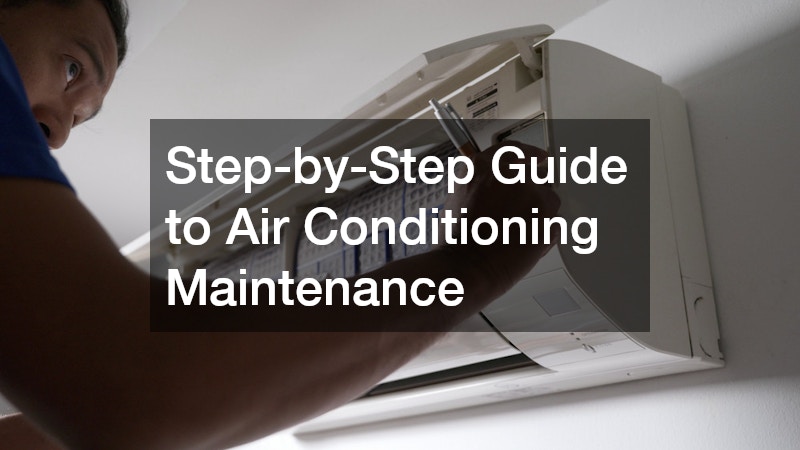Keeping your air conditioner in top shape is essential for maintaining comfort, reducing energy consumption and extending the lifespan of your system. Proper air conditioning maintenance not only prevents costly repairs but also ensures your unit operates efficiently throughout the hotter months. This guide outlines a detailed, step-by-step process to help you take care of your system and identify when to call in professional help.
Understanding the Importance of Regular Maintenance
Air conditioning systems are complex, comprising various components that must work in harmony. Over time, dust, debris and wear can diminish performance and cause strain on the system. Without regular upkeep, issues like poor airflow, refrigerant leaks and high energy usage can develop. Routine air conditioning maintenance helps prevent these problems and improves air quality within your home.
Scheduled inspections and cleaning help detect minor faults before they escalate into serious issues. Regular upkeep also ensures that your system complies with manufacturer warranties, which often require evidence of maintenance.
Start with Power Safety Precautions
Before beginning any air conditioning maintenance, ensure that the power is turned off at the switchboard or isolation switch near the outdoor unit. This is a critical safety step that protects you from electrical hazards during cleaning or inspection.
Once the unit is safely disconnected, allow it to cool down completely. This prevents burns and enables easier handling of components such as the filters, coils and fan blades.
Clean or Replace the Air Filters
Filters play a crucial role in trapping dust, allergens and particles from the air. When clogged, they obstruct airflow and force the system to work harder, leading to increased energy usage and reduced cooling efficiency.
Open the indoor unit and gently remove the filters. If they are reusable, vacuum them or wash with mild detergent and water. Allow them to dry completely before reinserting. If your system uses disposable filters, check the model and replace them as recommended—typically every one to three months, depending on usage and environmental conditions.
Inspect & Clean the Coils
Both the evaporator coil (inside) and condenser coil (outside) need attention during your maintenance routine. Dirty coils hinder heat exchange and reduce the system’s ability to cool the air effectively.
To clean the evaporator coil, remove the panel covering it and gently dust the surface using a soft brush. For a deeper clean, a no-rinse coil cleaner designed for indoor use can be sprayed directly onto the coil. For the outdoor condenser coil, remove any leaves, grass or debris from around the unit. Then, use a hose with gentle pressure to rinse away dirt from the coil fins, avoiding damage to the delicate metal.
Check the Condensate Drain
A blocked drain line can cause water to back up into the unit or the home, potentially causing water damage and mould growth. Locate the condensate drain line and ensure it is free of clogs or build-up. Flushing it with a mix of water and vinegar can help remove minor obstructions and sanitise the line.
If water is pooling around the unit or you notice musty odours, the drain may be fully clogged and require professional servicing.
Examine the Thermostat & Controls
While often overlooked, the thermostat plays a critical role in air conditioning maintenance. Ensure the thermostat is functioning correctly and accurately reflecting the room’s temperature. Programmable or smart thermostats should be reviewed to confirm they are set to energy-efficient temperatures, particularly during peak hours.
Test the system through a full cycle—from turning on the air conditioner to shutting it off—to verify that all controls respond appropriately. If you experience irregularities in temperature control, it may signal a fault within the thermostat or the control board.
Tighten Electrical Connections & Inspect Components
Electrical connections can loosen over time due to vibration and regular usage. Loose wires or corroded terminals can reduce the efficiency of the system or create a safety hazard.
Open the electrical compartment and visually inspect the connections. Tighten any accessible terminals and check for signs of wear or damage. Pay close attention to the contactor switch, capacitors and circuit board. If you detect any burnt smells or visible scorching, it’s best to call a licensed technician for a detailed inspection.
Test the Fan & Lubricate Moving Parts
Fans, belts and motors are essential to the proper functioning of your air conditioning system. Inspect the fan blades for dirt build-up or warping and clean them as needed. Older systems may have lubrication ports for motors and bearings; applying a few drops of oil can reduce wear and prolong component life.
Turn the system back on and observe the fan’s movement. It should spin smoothly without wobbling or producing unusual sounds. Noisy or erratic operation often indicates an alignment issue or a worn-out component.
Schedule Professional Servicing Annually
Even with diligent home maintenance, professional servicing should be scheduled at least once per year. A licensed technician can conduct a thorough inspection, check refrigerant levels, test airflow and use specialised tools to identify potential problems early.
This comprehensive service complements your routine air conditioning maintenance and ensures the system remains efficient, safe and compliant with industry standards.
Keeping Your Cool Year-Round
By following this step-by-step guide to air conditioning maintenance, you can enjoy reliable cooling, lower energy bills and fewer unexpected breakdowns. While many of these tasks can be performed at home, do not hesitate to seek expert help for more technical inspections or repairs.
Consistent air conditioning maintenance is an investment in your comfort and the longevity of your system. With the right care, your air conditioner will continue to perform at its best, no matter how high the temperature climbs.
.

